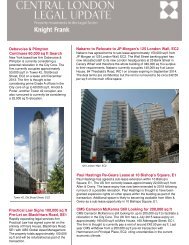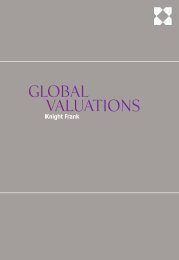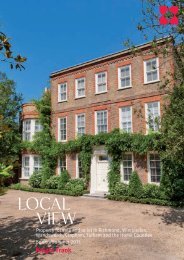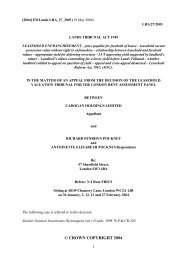40 Chelsea Square - Knight Frank
40 Chelsea Square - Knight Frank
40 Chelsea Square - Knight Frank
Create successful ePaper yourself
Turn your PDF publications into a flip-book with our unique Google optimized e-Paper software.
agreed to be an unusual house. Essentially the differences between the parties are matters of<br />
judgement.<br />
56. It is common ground, that due to an absence of comparable freehold sales, it is necessary<br />
to find the freehold value from leasehold sales, a process described as a “bottom up” approach.<br />
Both valuers recognise the inaccuracies likely to arise in this approach. It is also common<br />
ground that <strong>40</strong> <strong>Chelsea</strong> <strong>Square</strong> is one of <strong>Chelsea</strong>’s “more eye catching houses,” with a superior<br />
architectural appearance and in a location where prices are at the top end of the <strong>Chelsea</strong> price<br />
range.<br />
57. Against this background we look at the evidence. In our judgement, the starting point<br />
should be the price paid by Mr Arbib for the leasehold interest in <strong>40</strong> <strong>Chelsea</strong> <strong>Square</strong> in May<br />
1997. Although Mr Orr-Ewing and Mr Flint originally prepared their evidence on the<br />
assumption that Mr Arbib paid more than the “true value”, during the hearing Mr Flint<br />
accepted that Mr Arbib paid the market price to secure the house. We agree. This is, prima<br />
facie, the best evidence of value under the 1967 Act. It is the price paid for the house being<br />
valued; it reflects the value in an unimproved condition; and it reflects the listing. It is not<br />
therefore necessary to make any adjustments for these factors, Also, with regard to the Grade<br />
II* listing, although we recognise that this imposes greater restrictions on alterations than in<br />
respect of the unlisted comparables and no 41 with a lower Grade II listing, we have concluded<br />
that the higher listing reflects the particularly attractive features in no <strong>40</strong> which would appeal to<br />
a purchaser and offset any disadvantages of higher listing. Conversely, however, the price paid<br />
for no <strong>40</strong> suffers from two disadvantages: a short lease and the interval of six years between<br />
purchase and valuation date, both requiring substantial adjustments to produce the freehold<br />
value in April 2003. Nevertheless, the advantages of this evidence outweigh these<br />
disadvantages. We take this purchase as our starting point, to be checked against other<br />
comparable transactions.<br />
58. In analysing the price paid for <strong>40</strong> <strong>Chelsea</strong> <strong>Square</strong> and the comparables, we use a similar<br />
approach to that adopted (with minor differences) by Mr Flint and Mr Cullum to convert<br />
leasehold into freehold prices. This involves: a discount from the leasehold price for 1967 Act<br />
rights; the conversion to freehold value at purchase by relativities; and the indexed conversion<br />
of that value to value at the relevant date (1 April 2003). The adjusted prices provide the raw<br />
material for a judgement as to the freehold value of <strong>40</strong> <strong>Chelsea</strong> <strong>Square</strong>.<br />
59. The leasehold interest with approximately 30 years unexpired in no <strong>40</strong> was sold by<br />
informal tender in May 1997. Mr Arbib was the successful bidder at £4,762,531. This is now<br />
accepted to be the market value. The first adjustment is for 1967 Act rights, the leasehold<br />
purchased by Mr Arbib giving the right to enfranchise (subject to the residency qualification<br />
which then existed). Both valuers make a downward adjustment. Mr Flint used Mr Orr-<br />
Ewing’s relativities adjusted to an open market relativity (60% to 69.3%) to find the freehold<br />
value at the date of the purchase. Mr Cullum made two specific adjustments: first for 1967 Act<br />
rights and then to convert to the freehold value. Thus, Mr Flint converted the price paid by Mr<br />
Arbib into the freehold value by applying 69.3% (effectively 9.3% for the 1967 Act rights and<br />
60% no-Act relativity leasehold to freehold) to produce £6,872,339. Mr Cullum deducted<br />
10.3% for the 1967 Act rights and then used a relativity of 56.65% leasehold to freehold<br />
(overall 63.1% compared to Mr Flint’s 69.3%). Mr Cullum’s freehold value at May 1997 is<br />
14









